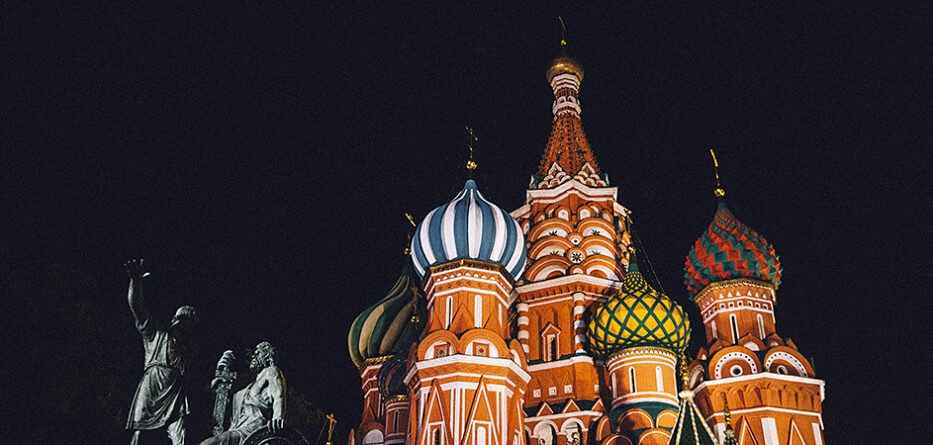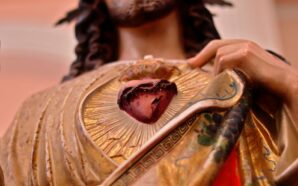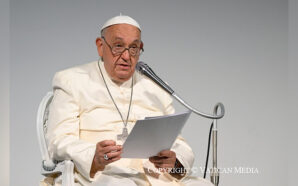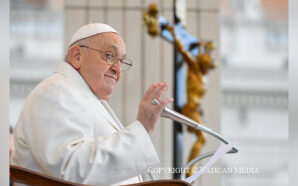From “Pacem in terris” to the March 2024 Moscow document on “a holy war defending the unified spiritual space of Holy Russia.”
There are certain documents that cast a dark, cosmic shadow. We have become used to seeing this in texts issued by various institutions linked to science (global warming), medicine (the pandemic), and the economy (poverty rates). But established Church authorities have tried in various and different ways over the past century to be messengers of hope.
The leaders of the Russian Orthodox Church, however, recently released a document on the future of our world that marks a departure from what we expect of religion. Called “The present and future of the Russian world”, this March 27 text is a step into the frightening unknown. It was not issued by the Moscow Patriarchate nor by the Holy Synod of the Russian Orthodox Church, which only approved it afterward. Rather, it comes from an institution whose name is commonly translated as the World Council of the Russian People. This entity was founded by Patriarch Kirill in May 1993 when he was still the Metropolitan of Smolensk and head of the patriarchate’s department of external relations. This council is both an ecclesial and patriotic institution made up of Russian Orthodox hierarchs, as well as high-ranking Kremlin officials, military leaders, university professors and hundreds of young patriots from all regions of Russia.
Holy war and expanded Russian territory
It held an extraordinary congress in the Cathedral of Christ the Savior in Moscow under the presidency of the patriarch, and approved this long text structured in eight sections. It is presented as “a programmatic document of the XXV World Russian People’s Council, as well as an order addressed to the legislative and executive authorities of Russia”. The most chilling part is at the beginning when it defines the war in Ukraine in these terms: “a holy war, in which Russia and its people, defending the unified spiritual space of Holy Russia, fulfill the mission of the ‘Holder’, protecting the world from the onslaught of globalism and the victory of the West fallen into Satanism. After the completion of the war, the entire territory of modern Ukraine is expected to enter Russia’s exclusive zone of influence”.
“The doctrine of the Trinity should be legislated, becoming an integral part of the Russian legal system. The Trinity should be included in the normative list of Russian spiritual and moral values and receive adequate legal protection,” it says. The document then proposes a series of social and economic measures to reassert a role of global power for “the Russian world” from a military, economic, and social-cultural point of view. For example, it dwells on the centrality to be assigned to the family, which must be “strong with many children” to ensure that the population of the Russian Federation, currently at 144 million, increases “to 600 million people within one hundred years of sustainable demographic growth”. It also pushes back against the liberalization of sexual mores. “The State must take comprehensive measures to protect the family and family values from abortion propaganda, sexual licentiousness and debauchery, as well as sodomy and various sexual perversions. Chastity and virtue, traditional for the Russian people, must return to Russian society,” the document says. It paints a picture of Russian society that is delusional for the future as well as for how it represents past: “The family is the foundation of Russian national life and the internal stronghold of the tradition of the Russian world.”
Moving further away from the Vatican
This new text further distances the Moscow Patriarchate from Vatican, though it is not the first to do so. The patriarchate’s official website published another document on March 25 called “On the Orthodox attitude towards the new practice of blessing ‘couples in an irregular situation and same-sex couples’ in the Roman Catholic Church”. It was written at the request of Patriarch Kirill by the Synodal Biblical-Theological Commission, which is chaired by Ilarion (Alfeev), Metropolitan of Budapest and Hungary. It is a response to the declaration on the “pastoral meaning of blessings” that the Vatican’s doctrinal office published last December 18 under the now well-known title Fiducia supplicans. The introduction to the Synodal Commission response states: “The ideas expressed in the declaration Fiducia supplicans represent a significant departure from Christian moral teaching and require theological analysis.”
The more recent document from World Council of the Russian People confirms the decision of Kirill and the Moscow Patriarchate to justify the war in Ukraine and its goal of eliminating the Ukrainian nation and absorbing it in the “Russian world”, all in the name of God. This was evident from the very first weeks after Russia invaded its neighbor, and it has not been just a matter of words, but also of actions, included liturgical actions.
But this document makes a step forward into the unknown. More than a theological or religious treatise, it sounds more like one of the Stalin-era “Five Year Plans of the Soviet Union”. It is one more evidence of the situation in which Putin’s Russia and Russian Orthodoxy have fallen into with their political and ideological axis.
“The Present and Future of the Russian World”
There are a number of proposals on social issues that do not look very different from other natalist and pro-family policies from the authoritarian regimes of the 1920s-1930s to the “illiberal democracies” of the 2010s-2020s. There are serious political, diplomatic, and ecumenical consequences – not talk about the meaning for the prospects of a negotiated solution for the war in Ukraine. Who knows what future historians will make of the joint declaration that Pope Francis and Patriarch Kirill signed in February 2016 in Havana (Cuba)? Some passages of that Havana statement sound particularly ominous today.
“The process of European integration, which began after centuries of blood–soaked conflicts, was welcomed by many with hope, as a guarantee of peace and security. Nonetheless, we invite vigilance against an integration that is devoid of respect for religious identities,” the joint statement says. “While remaining open to the contribution of other religions to our civilization, it is our conviction that Europe must remain faithful to its Christian roots. We call upon Christians of Eastern and Western Europe to unite in their shared witness to Christ and the Gospel, so that Europe may preserve its soul, shaped by two thousand years of Christian tradition,” the statement issued by the pope and patriarch also states.
But the most shocking part in the new document from the World Council of the Russian People, one that hits the reader instantaneously, is the theological or — better — religious core of the text, which is subtitled “The present and future of the Russian world”. It invokes an idea of the divine that is closer to that professed by Al-Qaeda than that which is found in the Gospel. It delineates an ethno-nationalist project that is a zero-sum game for relations between Russia and its many neighboring countries (not only in Eastern Europe, but also in Central Asia and China).
The return of “wild Christianity” where “man is wolf to man”
Most importantly, it revives the use of apocalyptic tones, which marks a deviation or complete U-turn from the post-1945 domestication and refinement of the relations between the Churches and the world, and those between the Churches and non-Christian religions. The theology coming out of this particular “symphonia” between the Moscow Patriarchate and President Putin is the opposite of what has been delineated in the Catholic tradition especially since John XXIII’s encyclical Pacem in terris (1963) and Vatican II’s constitution Gaudium et spes (1965). Those documents stress that Jesus brings a message of peace, not of national or ethnic supremacy, and that we can all be reconciled and coexist in a world where there is room for everybody. The Russian document shows us something much less reassuring — the face of the return of “wild Christianity”, the wilderness of a pre-civilization state of nature, the homo homini lupus (“man is a wolf to man”).
It is the end of what German theologian Johann Baptist Metz saw as the primacy of reconciliation in “bourgeois theology”. It would be interesting to know what Metz would say today about the Moscow Patriarchate’s apocalypticism and the eschatology it entails. This is not what Metz was hoping for when he articulated his critique of “bourgeois theology” as distinct from “messianic religion”. The messianism of the Moscow Patriarchate is an ethno-nationalist dystopia which takes the mounting criticism of the Western liberal system to its extreme, and possibly irreparable, consequences. But it’s certainly a sign of the crisis of the assumption, typical of the 1990s, that Christianity would accompany and help the transition to a post-Communist, post-ideological, and liberal world order. Instead, the largest Orthodox Church in the world has become the ideological pillar of a nuclear autocracy.
Moscow Patriarchate supplying ideological armor
The vision that the document from the World Council for the Russian People puts forward regarding Russia’s relations with the rest of the world, and those between its national Orthodox Church and the other churches and other religious traditions, is much darker than we have become accustomed to. This is especially true for those who live in the countries bordering Russia or geographically close to the largest country on earth (an internationally recognized land border extending more than 20,000 kilometers), or for the Russians who feel trapped in this “Russian world”.
This document is not just an ecumenical nadir, but also signals the limits (or even the impossibility) of a global Christian consensus today on the relationship between Christianity, peace, and coexistence in our common home, the planet earth. This document articulates with chilling clarity the alliance between Putin and Kirill: the Moscow Patriarchate, as leader of a State Church, tries to provide the post-Soviet Russian national project with a soul and a vision. At the time of the Soviet Union’s dissolution in 1991, there was no spiritual soul and moral vision except nostalgia for the glorious past of Russian Orthodoxy. The current Putin-Kirill symbiosis is the fruit of something that began more than thirty years ago.
The secular utopia that was promised by the Soviet Union and the neo-imperial “Christianist” arcadia for the regeneration of the Russian people that is described in this document have much in common. But one difference is that the Moscow Patriarchate of the Russian Orthodox Church, and not Leninism-Stalinism, is the one that is now supplying the ideological armor in this war manifesto – a war armed with nuclear weapons.
Reproduced with permission from La Croix International.








